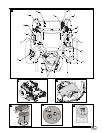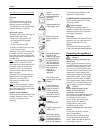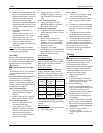
English Operating instructions
9
• Measure the distance between the
cutters’ front edge and the ground
and between the cutter’s rear edge
and the ground. The measured
distance from the front edge
should be 3–6 mm lower than the
distance from the rear edge. If this
is not the case, continue with the
next step.
• Loosen the two locknuts (3),
if installed.
Steadily tighten the nuts (1) to
raise the front side of the cutters;
steadily loosen the nuts (1) to
lower the front side of the cutters.
• When the sides are correctly
aligned, retighten the locknuts (3),
if installed.
Note!
You must make sure that the
hanger (4) is fully engaged to the stop
in the cutters’ pick-up hook.
Servicing
Observe the maintenance regulations
in the engine handbook. At the end of
the season a specialised garage must
inspect and service the appliance.
Caution!
Environmental hazard from engine
oil
After changing the oil, give unwanted
oil to an authorised disposal site or
company.
Environmental hazard from batteries
Used batteries do not belong in
household waste. Give unwanted
batteries to your dealer or a disposal
company. Remove the batteries before
the appliance is scrapped.
After 5 operating hours
• First engine oil change: see the
engine handbook for further
intervals.
• Quick oil drain (Fig 22) (option):
this is used for draining off oil.
Every 10 operating hours
• Clean or replace the air filter
(see engine handbook).
• Apply grease type 251H EP
through the nipples to lubricate
all cutter shafts, tension pulleys,
and tension pulley receivers.
This work must be performed at
a specialised garage.
• Apply grease type 251H EP
through the nipples to lubricate
the front wheels’ bearings and
axles.
Every 25 operating hours
• Apply grease type 251H EP
through the nipples to lubricate
the cutters’ front wheels.
Every 50 operating hours
• A specialised garage must remove
soiling and grass residue from the
drive gears.
Every 2 months
• Pressurise the front tyres to
approx. 2.3 bar and the rear tyres
to approx. 0.8 bar. See also the
manufacturer’s recommendation
on the tyre walls.
• For battery type 2 only:
Fill the battery cells with distilled
water until the level reaches 1 cm
below the filling aperture.
When needed
Cleaning the battery
Clean the battery at regular intervals.
Keep the battery terminals and cables
clean. Grease the battery terminals
with a little vaseline.
Charging the battery
Use a voltmeter to check the battery
voltage. When the voltage is lower
than 12.6 V (dc), the battery must be
charged in accordance with the table
(max charging current 6 A at 12 V).
Voltmeter
reading
Battery’s
charged
state
Requisite
charging time
12.7 V 100 % -
12.4 V 75 % approx.
90 min
12.2 V 50 % approx.
180 min
12.0 V 25 % approx.
280 min
Note! Observe the information in the
operating instructions for your battery
charger
Replacing fuses
• Replace defect fuses with fuses of
equal ratings only.
Once a season
• Lubricate the steering gear teeth
with a multipurpose grease.
• Lubricate the steering assembly’s
joints with a few drops of light
oil.
• Lubricate all rotating and bearing
sites (control levers, cutter height
adjuster, etc.) with a few drops of
light oil.
• Clean the spark plug and adjust
the electrode gap or replace the
spark plug (see engine handbook).
• The cutters must be sharpened or
replaced at a specialised garage.
Take the appliance to a specialised
garage for inspection and maintenance
once a season. Observe also the
instructions in the engine handbook
for engine maintenance.
Storing
Caution!
Material damage to the appliance
Keep the appliance only in clean and
dry rooms when the engine is cold.
For longer periods of inactivity,
protect the vehicle in all events against
rust, e.g. in winter. At the end of the
season or when the vehicle will not be
used for longer than a month:
• clean the appliance and
accessories,
• to protect metal parts from rust,
wipe them all down with an oiled
cloth or apply an oil spray,
• charge the battery,
• before winterising the appliance,
remove and charge the battery and
store this in a cool, dry place
(protected against frost); recharge
the battery every four to six
weeks and before installing it in
the appliance,
• drain off fuel (outdoors only) and
put the engine out of operation as
described in the engine handbook,
• lubricate the appliance adequately
at all points,
•
pressurise the tyres to the
respective values,
• keep the appliance in a clean, dry
room.

















